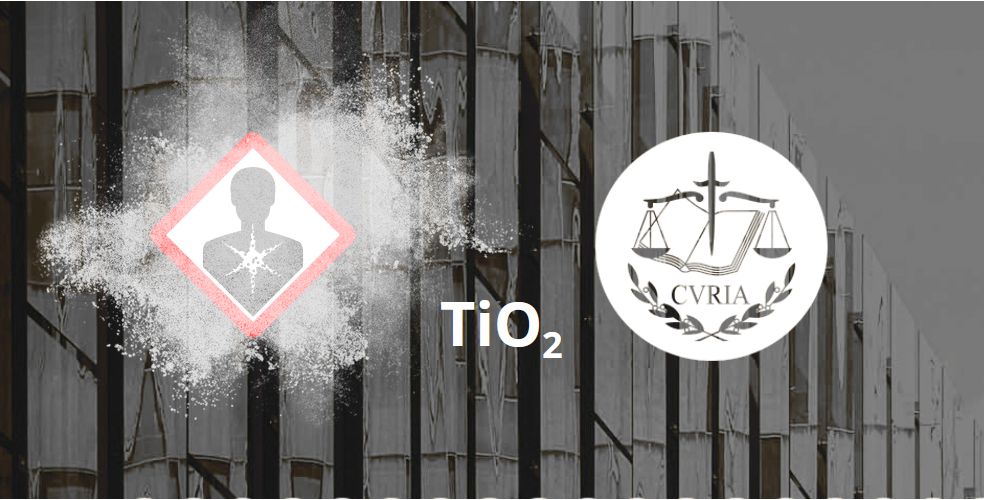
Lobbies score the overturning of titanium dioxide’s classification as an inhalation carcinogen
For over a decade, the classification of titanium dioxide (TiO₂) as a carcinogen by inhalation has been the subject of a tug-of-war between industry, which opposes it, and public authorities, which introduced it. Thousands of workers are exposed to this substance, which is widely used in paints, cosmetics, medicines, plastics, packaging, textiles and more. On August 1, in the middle of summer, the Court of Justice of the European Union (CJEU) ruled in favor of the industrialists, annulling the classification.
A ten-year battle
Background: Here is a summary of the key events in the long-running battle between industry and the French and European authorities, which has been ongoing for over ten years now1See our Infosheet Risks associated with titanium dioxide nanoparticles for more details.
- In 2014, ANSES, the French agency in charge of assessing the risks associated with titanium dioxide at the European level, faced repeated obstruction from manufacturers in obtaining data on the nanoforms they market in Europe. The companies refused to share this information and even brought the case to the Board of Appeal (BoA) of the European Chemicals Agency (ECHA).
- In 2016, ANSES proposed that TiO2 be classified as a suspected human carcinogen (1B)2See our Fact Sheet Risks associated with titanium dioxide nanoparticles for more details.
- In March 2017, the Board of Appeal allowed manufacturers to withhold details of their TiO2 nanoforms, on the grounds that the term ‘nanoform’ was not defined in Reach3 Cf. Decision of the board of appeal of the European Chemicals Agency, March 2017.
- In 2019, scientific experts at the European Chemicals Agency (ECHA) ruled that TiO2 is a ‘category 2 carcinogen by inhalation’, which is less stringent than that of ANSES, but which entails the obligation to warn workers of the dangers of TiO2 powders and dusts below 10,000 nm.
- In 2020, manufacturers and users of TiO₂ lodged an appeal with the General Court of the European Union (TUE) requesting the annulment of this classification, arguing that the studies on which it was based were not sufficiently ‘reliable’ and that titanium dioxide would not be ‘intrinsically‘ dangerous.
- In 2022, the TUE had sided with their arguments and issued a ruling to overturn the classification of TiO₂ as a category 2 carcinogen by inhalation4Cf. Industrials win (temporary) reversal of the classification of TiO₂ as a carcinogen, VeilleNanos, November 23, 2022.
- In 2023, the French government and the European Commission lodged appeals against this annulment5 Cf. Pending appeals from France and the European Commission, the classification of TiO2 stays, VeilleNanos, February 22, 2023, with the support of ECHA and the Dutch and Swedish governments.
- In November 2024, the European Commission, the French government and industrialists were heard at a hearing on the appeals lodged by France and the European Commission.
- Last February, the opinion delivered by the Advocate General of the Court of Justice of the European Union (CJEU) was rather favorable to maintaining the classification defended by France and the European Commission in their battle against lobbies.
The Court did not follow the opinion of the Advocate General
Contrary to the opinion of the Advocate General, the Court’s judges decided to uphold the annulment of the classification… while acknowledging that the court had exceeded the limits of its legal powers.
→ See the CJEU’s press release.
→ See theCJEU’s detailed judgment.
Dismay among health professionals, scientists and NGOs
The CJEU’s decision was widely covered in the media thanks to an AFP newswire (see below). Initial reactions from Foodwatch, AVICENN, Générations futures, and the French Ministry of Labor, as reported by AFP, all point in the same direction: the ruling is “a highly regrettable setback in terms of worker information and protection.” The warning pictogram and message alerting workers will no longer be mandatory on packages of TiO₂ powder handled by workers.
As the news spread during this suspended time of the summer period—when many health professionals, toxicologists, biologists, unions, safety officers, and others are on vacation—amazement, dismay, and even outrage are emerging.
→ How could judges, who are not experts in toxicology, overturn a classification that was supported by consistent risk assessments conducted by scientific experts from ANSES and ECHA?
At this stage, while the lobbies are rubbing their hand with satisfaction6See for example the reaction of Hans-Helmuth Schmidt’s on the European Coatings website, it is essential to emphasize that this court decision cancels the classification regulations for TiO₂… but not the cancer risks for workers!
The icing on the cake? France and the European Commission will have to reimburse the manufacturers for their legal and procedural costs. All this comes at a time when public funding to support toxicity studies has melted away… while the titanium dioxide industry continues to invest “millions of euros in various scientific programs to confirm the harmlessness of TiO2” (sic), as the titanium dioxide manufacturers’ federation (TDMA) reminded us a few months ago7 Cf. https://www.tdma.info/news/opinion-of-the-advocate-general-on-the-classification-of-titanium-dioxide.
What’s next?
According to Natacha Cingotti8Dioxide de titane déclassifié des substances cancérogènes : “Un recul pour la protection des consommateurs et des travailleurs”, Libération, August 1, 2025 in charge of Foodwatch’s international campaign strategies and member of AVICENN’s board, in legal terms, all appeals have been exhausted. Consequently, “France could decide to propose a new classification on the basis of new data or by starting the dossier from scratch. But that would mean losing seven or eight years’ work.”
In the meantime, as we wait to find out more about the action to be taken by public authorities, trade unions and NGOs, studies and information on the dangers of TiO2 must continue, especially when this TiO2 is in the form of nanoparticles. Without this information, workers cannot take the necessary steps to protect themselves.
Note: the International Agency for Research on Cancer’s classification of titanium dioxide as a cancer-causing agent remains in force.
Media coverage
Although published in the middle of summer, the CJEU’s decision was widely reported in the media, thanks in particular to an AFP dispatch:

Other nano-related news
Next nano events

- 10th International Conference on Nanoscience and Technology
- Organized by: Chinese Academy of Sciences and Chinese National Center for Nanoscience and Technology
- Website: http://www.chinanano.org.cn/en/

- E-learning program: awareness-raising for personnel who come into contact with nanomaterials during research, formulation, production, maintenance, cleaning, upkeep, etc., as well as safety coordinators or engineers, facility managers, heads of laboratories where nanoparticles are handled.
- Organizers: INSTN Grenoble (CEA)
- On the program:
- 1 – Introduction, definition and characteristics of nanomaterials
- 2 – Toxicity of nanomaterials: the state of knowledge
- 3 – Metrology and characterization of nanomaterials
- 4 – Prevention and protection against nanomaterials in the workplace
- 5 – Quiz: assessment of learning outcomes
- The 2-hour course can be viewed for one month from the date of registration.
- Website: https://instn.cea.fr/…risques-lies-aux-nanomateriaux…

- International Conference on Advanced Nanotechnology and Nano Materials
- September 22 & 23, 2025
- Website: https://advnanotech.authorsequity.org
Notes and references
- 1See our Infosheet Risks associated with titanium dioxide nanoparticles for more details
- 2See our Fact Sheet Risks associated with titanium dioxide nanoparticles for more details
- 3Cf. Decision of the board of appeal of the European Chemicals Agency, March 2017
- 4Cf. Industrials win (temporary) reversal of the classification of TiO₂ as a carcinogen, VeilleNanos, November 23, 2022
- 5Cf. Pending appeals from France and the European Commission, the classification of TiO2 stays, VeilleNanos, February 22, 2023
- 6See for example the reaction of Hans-Helmuth Schmidt’s on the European Coatings website
- 7
- 8



